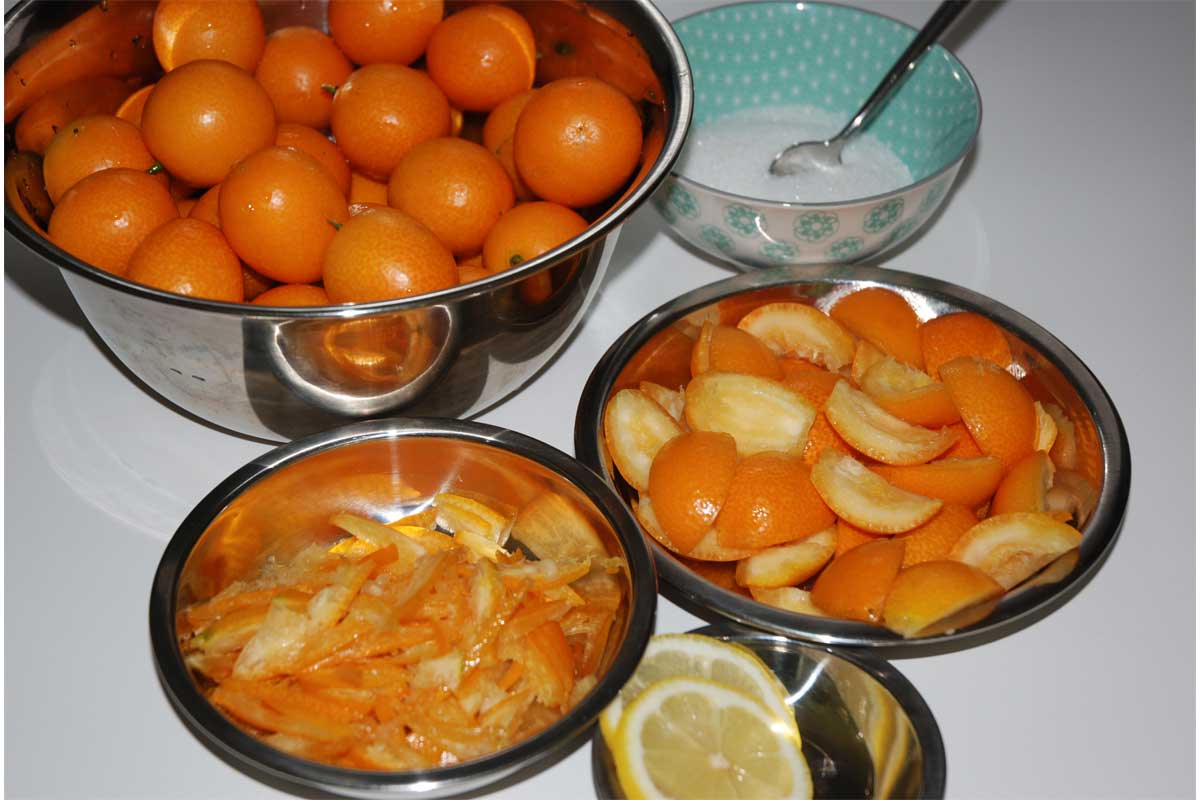Kumquat marmalade with lemon is a very refreshing jam more so than orange peel marmalade. This surprising fruit from East Asia, that is harvested towards the end of the short winter, is not to missed. The marmalade can be stored for over a year in a cool and dark place.
Origin and the art of making kumquat marmalade with lemon
Kumquats are part of the citrus family (citrus japonica) and originate from South and East Asia. Their name is directly derived from the Cantonese dialect, where ‘gam gwat’ means ‘golden orange’. The fruits are indigenous to middle and south China, including Taiwan, as well as in Korea and Japan. The plants, especially the ones with oval fruits, are winter hardy and can stand temperatures as low as -10 C. However, the plants need hot summers with temperatures between 25 and 37 C. The plants grow in middle and south China’s gardens with cool winters and some snow and scorching hot summers. The plants bear fruit towards the end of the short winter, around Chinese spring festival.
Most of the (sweet) flavour is in the peel. The flesh is tart and to make marmalade, the whole fruit is used, except for the pits and some hard parts of the white interior. Kumquats in this respect are opposite to oranges, where we usually eat the flesh and discard the peel: kumquats are all about the peel. Fresh kumquats can be eaten whole (including the seeds) but may be a bit tart. They contain loads of Vitamins (especially Vitamin C) and many polyphenols in the peel.

Kumquat marmalade with lemon
Ingredients
- 4 lbs (2kg) kumquats
- 1 lemon
- 1 lb (450 g) sugar
- 3 pints (1,5 liter) water
Instructions
- Wash the kumquats and the lemon with water and a brush
- Cut the green top from the kumquats
- Then cut them in quarts
- Remove the inner part and at the least the seeds and the harder white interior and discard that
- Cut the quarts (mostly the peel is left) over the length in fine slices
- Cut the lemon in fine slices and remove the seeds. Cut in small pieces (especially also the peel).
- Then weigh the finely sliced kumquats and lemon (we had a little more than 3 lbs, 1.5 kg left)
- Add 30% sugar based on the weight of the kumquats (so if the kumquats weigh 1500 g, add 450 g sugar)
- Add the same weight of the kumquat+lemon slices as water (around 3 pints or 1.5 liter)
- Bring the kumquat slices, the lemon slices, the sugar and the water to a rolling boil and cook it for 1.5-2 h, thereby regularly stirring and especially towards the end mixing well, so that there is no sugar caramelization
- When sufficient thickness has been achieved, fill cleaned jars with boiling water and then empty these, just before filling them with the very hot marmalade. Cap the jars and place them upside down to cool. When they have cooled place them in the fridgeThe jars can be stored this way for several months in the fridge. Please note the sugar content is not high enough for infinite storage at room temperature, but high enough for prolonged storage in the fridge. We registered 3 lbs, 4.3 oz (1483 g) of marmalade as yield, which means that all the water and some water of the kumquat juices had evaporated.
Notes
Remarks
- This marmalade has a sugar content of over 30%. If you prefer a marmalade with less sugar, accept a slightly thinner formulation with a shorter storage time.
- Kumquat gel, the viscous liquid that envelops the kumquat peel slices in the marmalade pairs excellently with salt cured vegetables



